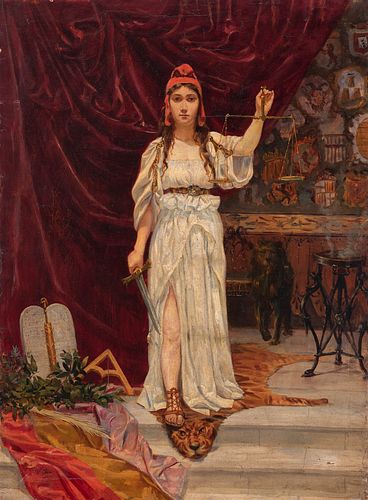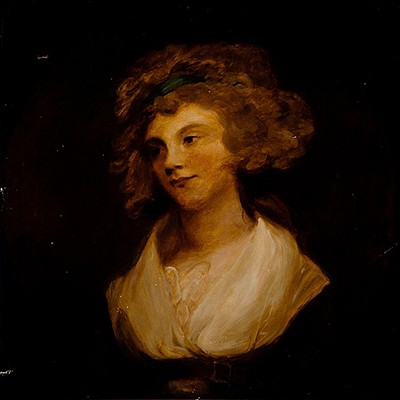Attributed to ULPIANO CHECA Y SANZ (Colmenar de Oreja, Madrid, 1860 - Dax, France, 1916). "Justice". Oil on canvas. Relined.
About Seller
Carrer Aragó 346
Barcelona
Spain
Setdart Subastas was born in 2004 and is currently the first online art auction in Spain with solidity, prestige and reliability guaranteed by our more than 60,000 users. Setdart has a young, dynamic and enterprising team ready to successfully manage the purchase and sale of art works through custom...Read more
Two ways to bid:
- Leave a max absentee bid and the platform will bid on your behalf up to your maximum bid during the live auction.
- Bid live during the auction and your bids will be submitted real-time to the auctioneer.
Bid Increments
| Price | Bid Increment |
|---|---|
| EUR€0 | EUR€10 |
| EUR€200 | EUR€25 |
| EUR€500 | EUR€50 |
| EUR€1,000 | EUR€100 |
| EUR€3,000 | EUR€200 |
| EUR€5,000 | EUR€500 |
| EUR€10,000 | EUR€1,000 |
| EUR€20,000 | EUR€2,000 |
| EUR€50,000 | EUR€5,000 |
About Auction
Nov 25, 2021
Setdart Auction House sofia@setdart.com
- Lot Description
Attributed to ULPIANO CHECA Y SANZ (Colmenar de Oreja, Madrid, 1860 - Dax, France, 1916). "Justice". Oil on canvas. Relined. It presents faults in the polychrome, restorations and repins. Measurements: 88 x 65,5 cm. Allegory of justice in which the author presents us with a young woman dressed in a white tunic in the Roman way and Phrygian cap. In her right hand she holds the scales, while with the other she grasps a dagger. The highly symbolic scene is completed with a sumptuous interior on whose floor is a flag similar to that of the republic, and a wallpaper that decorates the room with numerous noble coats of arms. Ulpiano Checa began his artistic training in 1873, at the School of Arts and Crafts in Madrid. In 1876 he went to the San Fernando Academy, where he became a disciple of Federico de Madrazo. When he finished, in 1884, he obtained a pension to study at the Spanish Academy in Rome. During his third year he sends a work that will earn him the first medal at the National Exhibition of 1887, and second at the Universal Exhibition of Vienna in 1888. At the end of 1887 he took up residence in Paris, where he exhibited regularly in the Salons, achieving success when his work was awarded a prize in 1890. There he combines painting with his work as a graphic correspondent in "La Ilustración Española y Americana". At the beginning of the century he settled in the south of France, in Dax, where he remained until his death in 1916. It is important to highlight how Checa's work influenced the adventure films of Hollywood in the 50s and 60s. Film directors such as Stanley Kubrick ("Spartacus"), Mario Bonnard ("The Last Days of Pompeii"), Mervyn LeRoy ("Quo Vadis"), William Wyler ("Ben-Hur") or, more recently, Ridley Scott ("Gladiator") were inspired by his works for their scenery, costumes, study of mass movements and characterization of characters. In fact, he also influenced earlier filmmakers, since in the 1930s and 1940s his work showed directors the possibility of creating visual effects of depth and perspective unusual in cinema until then. During his lifetime, in 1901, he collaborated with Henry Sienkiewick on the set and costume design for the theatrical version of the novel "Quo Vadis". In fact, part of Checa's work is based on literature, especially this novel, "Ben-Hur" and "Les Miserables". Works by Ulpiano Checa are kept in the Museo Municipal Ulpiano Checa de Colmenar de Oreja, the Museo del Prado, the Museo Nacional de Bellas Artes de Buenos Aires and the Museo de la Real Academia de Bellas Artes de San Fernando, among others.
Dimensions:
INV Number:
88 x 65,5 cm.
35256486 - Shipping Info
-
In-house shipping available. Please inquire at admin@setdart.com.
-
- Buyer's Premium



 EUR
EUR CAD
CAD AUD
AUD GBP
GBP MXN
MXN HKD
HKD CNY
CNY MYR
MYR SEK
SEK SGD
SGD CHF
CHF THB
THB















